The All Blacks remain the flagbearers for the global game and this analysis shows how effective they can be in attacking from the set-piece
They say you cannot score tries from set-piece at the highest level any more. They are wrong. Over the past few years, New Zealand has steadily taken over from Australia as the no.1 expert at attacking from scrums and lineouts, and one of their favoured methods was on show against Argentina in round three of The Rugby Championship (see Sky Sports’ highlights below)
The try came from an All Blacks’ left-side scrum in the Pumas 22m zone, which is one of the most attractive start positions for a successful first phase attack. Why? Because the scrum-half (a key figure in the defensive pattern) begins the set-piece on the wrong side of the play, close to the side-line.
A shot from behind the posts as the scrum sets up shows the significance of the scrum-half’s positioning:

All the New Zealand backs, including the blind-side wing Julian Savea can line up on the open-side of the field. Here Savea sets up directly behind the scrum. On the defensive side however, the No 14 Matias Moroni is committed to defending the short-side if a move develops in that area.
Furthermore, the No 9 Martin Landajo is going to have difficulties circling all the way around the set-piece to become a real factor on the opposite side of the field. Unless Argentina get it exactly right, they will be potentially two men down when the ball goes out to the New Zealand right.
The ball is safely won, and next stage of the process is a game of chess between Savea and Landajo, with the Kiwi left wing using multiple movements to encourage the Puma half-back to stay on the short-side.

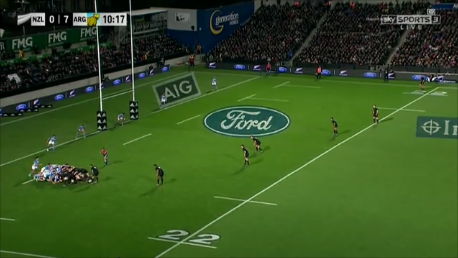
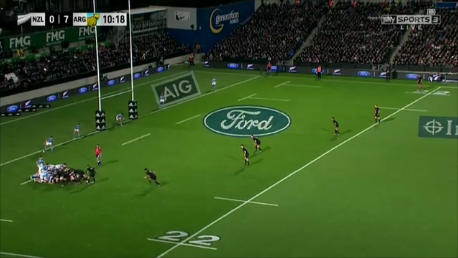
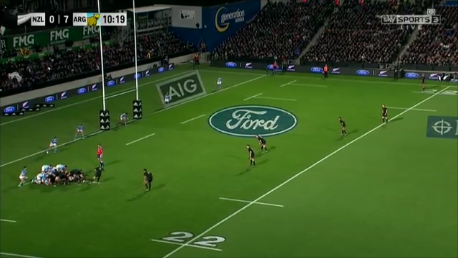
Savea starts behind the scrum (10:16), takes a small step to his right to drag Landajo over to the open-side (10:17), then fakes back to the short-side to pull the Argentine scrum-half across towards touch again (10:18 & 10:19). His double decoy has the poor halfback reacting like a puppet on a string, and in the end shot Savea has what he wants. He and Landajo are on opposite sides of the scrum as Kieran Read goes to pick the ball up at the base.
When the New Zealand No 9 Aaron Smith receives the ball from Read, the gap between Landajo and Savea has widened out to approximately 8 metres, with Savea already on Smith’s outside shoulder and Landajo still a couple of metres shy of the referee (Nigel Owens in orange):

Landajo’s absence from the defensive pattern means that New Zealand have successfully engineered a three-on-two in midfield. The Puma No 10 Nicolas Sanchez has to take Smith, while the No 12 Juan Martin Hernandez has to make a choice between two runners on very different angles – No 12 Ryan Crotty crashing down on an acute angle to his inside, and Savea flaring out towards the corner flag.
In the event Hernandez chooses to stay for Crotty, leaving Savea a clear path to the outside and the goal-line:
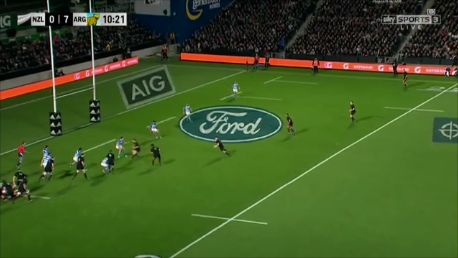
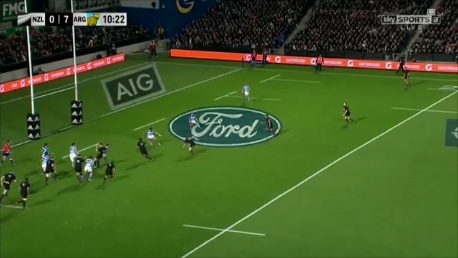
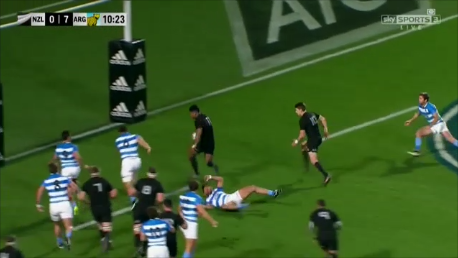
None of this is new, even though the New Zealand coaches and players have added refinements to the same basic pattern over the years. They were still running the same package back in 2013 in an end-of-year tour match against France.
At a left-side scrum on the France 22, the French No 9 Morgan Parra looks at first glance to be in pretty good shape, shifting across to the open-side of the defence at 2:05 as the ball reaches the base of the scrum:
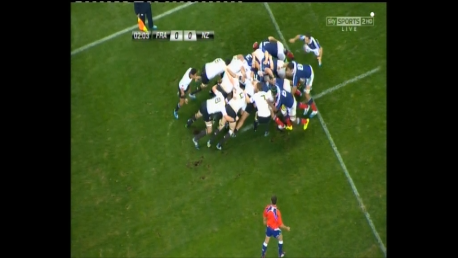
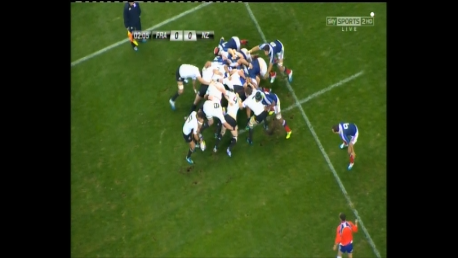
However, Aaron Smith’s excellent left-handed pass brings first receiver Dan Carter on the advantage-line with Parra level with the referee and still well short of defending the Kiwi #10, as New Zealand once more prepare to cross over their No 12 (Ma’a Nonu) and the blind-side wing (No 11 Charles Piutau) outside him:
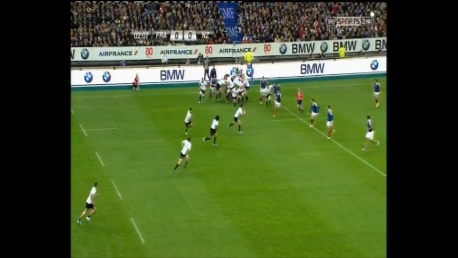
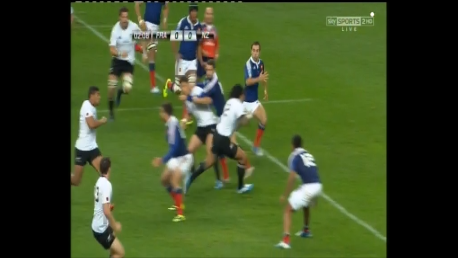
As in the Argentina example, the French No 10 (Remy Tales) takes the 1st receiver, leaving his inside centre (No 13 Florian Fritz) to make the decision whether to move out on to Piutau or stay inside on Nonu. Eventually Fritz shifts out on to Piutau, leaving Ma’a Nonu free to take the short ball and make the break inside him.
*
What does this all prove? Above all else, it demonstrates a continuity in coaching and rugby thinking that no other rugby country in the world can match. While different players have passed through the All Black jersey since late 2013, with Savea replacing Charles Piutau and Crotty now performing the role that belonged to Ma’a Nonu for so many years, the systems and patterns have in many cases either stayed roughly the same, or simply evolved to become more efficient (Savea’s cat-and-mouse with Landajo).
The core of the coaching group is still there too – head coach Steve Hansen, ‘the Professor’ Wayne Smith, Ian Foster and Mike Cron. This is the great strength of the New Zealand system. The ’head’ of the group remains stable and conscious of everything that went before it, even when legs that do the running and kicking, and the hands that do the passing, change.
None of the All Blacks’ closest traditional rivals can say the same. The route that led from Heyneke Meyer to Alistair Coetzee in South Africa, or Ewen McKenzie to Michael Cheika in Australia both involved more upheaval than evolution.
Until another country can muster the same continuity and cohesion of thinking, they will not be able to effectively pass on the crown to the next generation of coaches and players, and it will be only the All Blacks who remain what they truly are – rugby royalty.
Watch the Rugby Championship live on Sky Sports. Sign up now and receive three months half price. http://www.sky.com/shop/tv/sports?DCMP=bac-SS.com-3month_strapline





